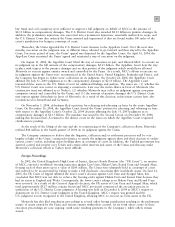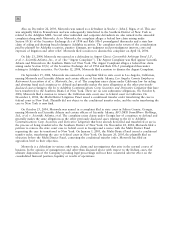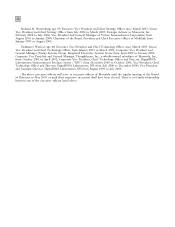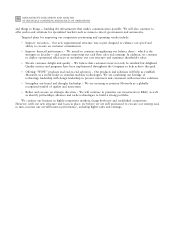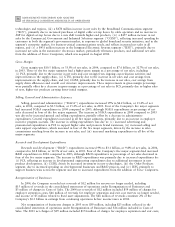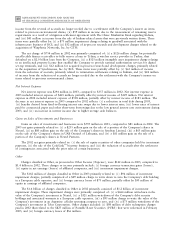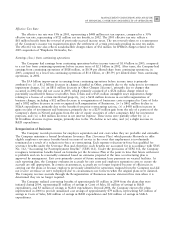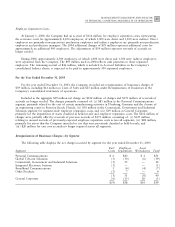Motorola 2004 Annual Report Download - page 41
Download and view the complete annual report
Please find page 41 of the 2004 Motorola annual report below. You can navigate through the pages in the report by either clicking on the pages listed below, or by using the keyword search tool below to find specific information within the annual report.
33
MANAGEMENT'S DISCUSSION AND ANALYSIS
OF FINANCIAL CONDITION AND RESULTS OF OPERATIONS
growth, we believe we gained market share in 2004 and solidiÑed our hold on the second-largest worldwide
market share of wireless handsets. This increase in net sales, accompanied by process improvements in the
supply chain and beneÑts from ongoing cost reduction activities resulted in increased gross margin, which
drove the increase in overall operating earnings for the business. The segment continues to experience
intense competition in worldwide markets from numerous global competitors. As these strong competitive
pressures continue in the industry, which typically experiences short life cycles for new products, the time
to market for new product oÅerings becomes increasingly more important. The segment will continue to
focus on investment in innovative and next-generation technologies to ensure we introduce industry-leading
products.
‚In GTSS: Our wireless networks business experienced a 24% increase in net sales in 2004, reÖecting
increased net sales in all technologies and all regions. In addition to the increase in net sales, the business
also had a 207% increase in operating earnings. Although the increase in net sales was the key driver of the
increased earnings, further cost containment in the segment's supply chain also contributed. The wireless
infrastructure industry experienced signiÑcant growth in 2004 after three years of decline. We believe that
our wireless networks business' net sales growth outpaced the industry, resulting in increased market share
in 2004. The business continues to face signiÑcant competition in worldwide markets. In particular, the
competition to win awards to supply equipment for next-generation 3G UMTS equipment remains intense.
‚In CGISS: Our public safety and enterprise communications business had an 11% increase in net sales and
a 34% increase in operating earnings in 2004 compared to 2003. The net sales growth reÖects increased
spending for communications equipment in the public safety markets, primarily in response to homeland
security needs, as well as increased spending by our business customers in the enterprise markets. In
addition to the increase in net sales, improved supply chain eÇciencies and overall cost structure
improvements drove the improvement in earnings. The segment continues to expand their product and
technology oÅerings and is increasing its focus on large enterprise customers by oÅering a broader set of
communication solutions, evidenced by their acquisition of MeshNetworks, Inc., a leading developer of
mobile mesh networking and position location technologies. In the government market, the business
continues to work closely with the appropriate government departments and agencies to ensure that
wireless communication is positioned as a critical need for homeland security.
‚In IESS: Our automotive, embedded computing and energy systems business had a 19% increase in net
sales in 2004, although operating earnings decreased 12%. The growth in net sales was driven by the success
of the Automotive Communications and Electronic Systems Group, primarily from telematics products, as
well as the success of several new electronic controls products. Also contributing to the increase in net
sales was the acquisition of Force Computers, a worldwide designer and supplier of open, standards-based
and custom embedded computing solutions. The primary reason for the decrease in operating earnings was
increased employee incentive accruals, increased research and development and selling, general and
administrative expenditures, and integration costs associated with the addition of Force Computers.
‚In BCS: Our broadband business had a strong year in 2004, as net sales increased 26% and the business
reported operating earnings versus an operating loss in 2003. The increase in net sales was driven by
increased demand for digital cable set-top boxes, increased ASP for digital set-top boxes due to a product
mix shift towards higher-end products, and increased retail sales. The segment remains the market share
leader in both digital set-top boxes and cable modems. As the digital business continues to account for a
substantial portion of the segment's business, we continue to focus on producing a suite of digital set-top
terminals, primarily higher end set-top boxes. As the product mix shifts towards these higher-end products,
the business continues to seek ways in which to reduce the cost, as we have historically seen lower initial
margins on these products.
Focusing on 2005
In 2005, we will continue to pursue proÑtable market share growth. After aligning our structure to better
enable our vision of seamless mobility, we will serve our customers through four distinct but integrated business
units: mobile devices, networks, government & enterprise and connected home.
Within this framework, we will continue to design and develop devices (consumer and professional) for
mobile communications, partnering with retail and enterprise operators to create compelling, ""must-have'' designs
and functionality. We will continue to design and develop networks to connect people to people, people to things


